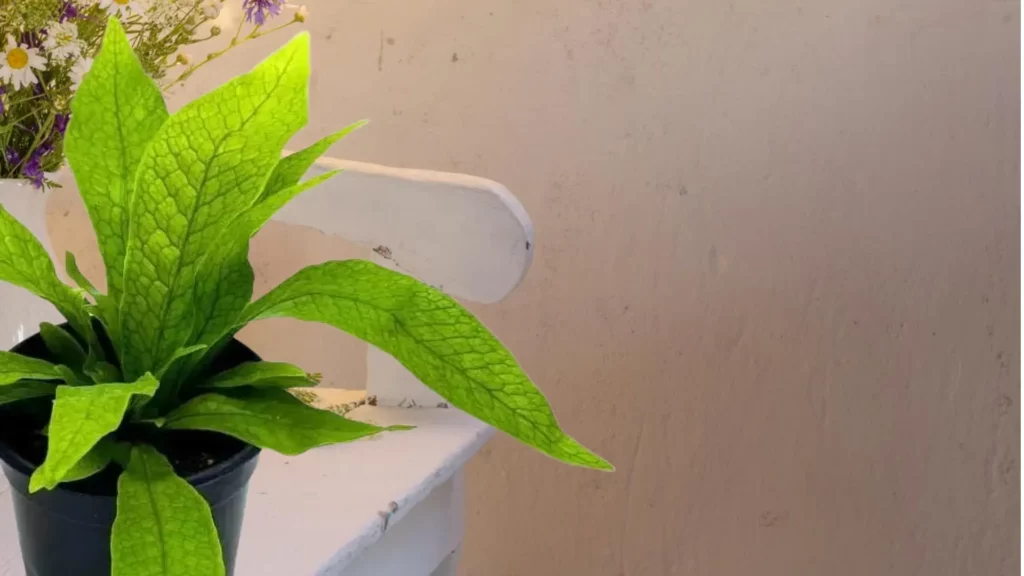At a Glance
- Common Name: Crocodile Fern, Crocodyllus Fern
- Scientific Name: Microsorum musifolium
- Native Region: Southeast Asia, Australia
- Lifespan: Perennial
- Plant Type: Fern, Epiphytic or Terrestrial
- Size:
- Height: 2-5 feet
- Width: 2-3 feet
- Planting Zones: USDA Zones 10–12 (can be grown indoors in cooler climates)
- Soil Requirement: Well-draining, rich, organic soil; prefers slightly acidic to neutral pH
- Water Requirement: Moderate to high; prefers consistently moist but well-drained soil
- Sun Exposure: Partial to full shade; indirect light when grown indoors
- Foliage Color: Bright green with a unique, crocodile-skin-like texture
- Foliage Season: Evergreen
- Flower Color: Non-flowering (as typical for ferns)
- Fruit: None (reproduces via spores)
- Wildlife: Provides shelter for small insects; non-toxic to pets
Introduction
One of the most popular, interesting, and unusual plants in Australia is the Crocodile Fern, which looks wrinkled. Externally, the plant is characterized by light green, segmented dark green veins and wrinkled, ripe leaves.
Although it may sound strange, the real reason for naming this plant crocodile fern is the unique texture of the plant, whose crinkled leaves have been compared to crocodile skin, but if we look at the plant, it is truly strangely beautiful.
Tips to grow Crocodile Fern
Crocodile fern is a type of exotic domesticated plant whose skin resembles that of a crocodile. Crocodile fern is a native and well-known plant of the Australian tropics that grows well in warm and humid conditions.
Growing crocodile ferns at home can be a very strange and self-indulgent adventure, and if you are thinking of growing them, follow these tips that will help you cultivate a thriving crocodile fern:
Choosing the right place
Crocodile ferns generally grow well in bright and indirect light. If you want to grow crocodile ferns very quickly, place them near an east or north-facing window, if possible. Avoid direct sunlight because the leaves of these plants ripen after they have grown. If you place them in direct sunlight, it can scorch the beauty of the plant.
If you don’t have the option of indirect lighting, you can consider using grow lights to supplement their needs.
Maintain the right temperature
Australia’s famous crocodile fern is a spectacular houseplant. It needs temperatures between 65°F and 80°F to grow well. It cannot tolerate cold temperatures. A seasoned gardener installs heaters to keep such plants alive even in winter.
Essential for the health benefits of crocodile ferns is proper humidity, which should be aimed for at least fifty percent. If your surrounding climate is dry, you can use a humidifier to maintain humidity.
Choosing suitable soil
Soil plays an important role in the proper growth of any type of plant. Each type requires a different type of soil. Good drainage is essential for crocodile ferns with nutrient-rich, protein-rich soil.
You can use a mixture containing pine bark to maintain proper soil quality and provide good aeration and moisture retention. You must not use heavy and compacted soil, as it will thwart your efforts and rot the roots of the plant.

Regular watering
Setting a regular watering routine is essential for good growth of the crocodile fern, but since this plant requires moist soil, it should not be waterlogged. Since this plant grows very quickly in the summer, keep an eye on it and water it if the above-ground part of the plant dries out.
Pruning and maintenance
To encourage and maintain the beautiful growth of the tree, regularly prune the yellow leaves. This not only makes the tree beautiful but also encourages you. Regular cleaning with a damp cloth to remove dust will help maintain the plant’s beauty.
Pest and disease management
If you are an expert gardener, you know that crocodile ferns are disease-resistant but can occasionally attract spider mites, so inspect the leaves regularly and use insecticidal soap or neem oil. If you are unable to find a solution even after trying home remedies, you can buy pesticides from the market that will not harm the plant and will help your plant to survive.
Fertilizer
Crocodile ferns grow very easily and healthily on their own, but if you notice that the plant is growing very slowly, you can use a good-quality fertilizer.
Solve common problems
When you grow crocodile ferns at home, you will notice that you will occasionally face several common problems and try to resolve them immediately.
● If you notice that the plant has several yellow leaves, it could indicate overwatering or low soil fertility.
● Brown leaves indicate dry air or inconsistent watering.
● Slow growth of the plant indicates that it is not getting enough light or that the plant is definitely lacking nutrients.
Conclusion
With proper care, a crocodile fern can beautifully add an unusual beauty to your home, growing well in a limited space like your balcony. You will need to spend some time and pay attention to the right amount of water, light, and humidity to help the plant grow well. Growing a fern like this can be a stunning addition to your balcony.
